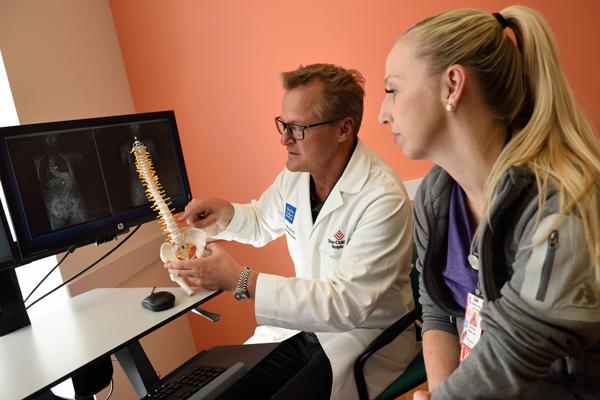min. read
Topics
Image

To accurately diagnose scoliosis and other spinal deformities, physical exams, X-rays, MRIs and bone scans may be used. If there is a curve detected, the spine specialist will measure the curve in degrees. From there, the spine team will work with the patient and their families to discuss treatment options based on the:
- Degree, type and location of the curve
- Age, health and medical history of the patient
- Underlying cause of deformity
- Extent of the condition
- Patient’s tolerance for specific medications, procedures or therapies
- Expectations for the course of the condition
- Patient family’s opinion or preference
Diagnostic X-Rays
Many parents are concerned about exposing a child with medical conditions to frequent X-rays. Texas Children’s Hospital was the first pediatric institution in the southwest to adopt the EOS low dose X-ray, which emits significantly less radiation than traditional imaging technologies. A determination for treatment can often be made based on this measurement alone.
Other diagnostic tests include:
- Bone Scans: Bone scans are a nuclear imaging method to evaluate any degenerative and/or arthritic changes in the joints. It also can detect bone diseases and tumors and can determine the cause of bone pain or inflammation. This test is to rule out any infection or fractures.
- Magnetic Resonance Imaging (MRI): This diagnostic procedure uses a combination of large magnets and a computer to produce detailed images of organs and structures within the body. This test is done to rule out any associated abnormalities of the spinal cord and nerves.
- Computed Tomography (CT) Scan. A CT scan uses a combination of X-rays and computer technology to produce horizontal images (often called slices) of the body. A CT scan shows detailed images of any part of the body, including the bones, muscles, fat and organs. CT scans are more detailed than general X-rays.
- Blood Tests and Physical Exams: Early detection of spinal conditions is important for successful treatment. Pediatricians, family doctors and some school programs routinely look for signs that spinal deformities may be present.
23916
Conditions
article
